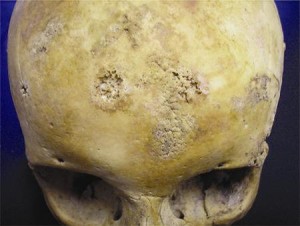A great deal about the health of individuals interred at St Nicholas Kirk can be learned from their remains uncovered during the archaeological dig. This is one example, others will also be featured, which perhaps comes as a surprise.
From both archaeological and written records, it appears that syphilis was unknown in Europe until the 1490s. It rapidly became a common venereal disease. It is caused by a micro-organism called Treponema pallidum – a spirochete for those interested. An infection can pass through three distinct stages if untreated. The initial stage is of a skin lesion at the site of infection – primary syphilis. Secondary syphilis occurs up to 6 months later and is characterised by a general rash. It may then enter a dormant phase which can last for several decades before entering the final tertiary phase. In this there are soft tissue swellings, called gumma, but these cannot be seen in archaeological specimens. However, there can be changes to the bone and this is how we know that there was at least one case of syphilis uncovered during the archaeological dig in the former East Kirk in 2006.

The photograph is of the skull of a person, probably male, aged between 17 and 25 years old. On it can be seen the characteristic lesions caused by tertiary syphilis. These lesions start as a small depression on the skull, called Caries Sicca, associated with inflammation in the tissue immediately in contact with the bone. This gradually deepens and widens and later new bone is deposited around the edge, giving a slight ridge (called a periosteal reaction). There can be similar reactions on other bones of the body. There were such lesions on all the ‘long bones’ of this person, but these lesions are not as easy to see or as distinctive. It can only be speculation, but the feeling is that whilst this young person could have acquired the infection through his own actions, it is equally possible that this is a case of so called congenital syphilis; in other words, his mother infected him before or during his birth.
We are very grateful to Dr Paul Duffy, our human bone specialist during and following the dig, for his detailed analysis. (His website is http://www.discoverbutearchaeology.co.uk/) The photograph is copyright Aberdeen Art Gallery & Museums Collections and is used with permission.